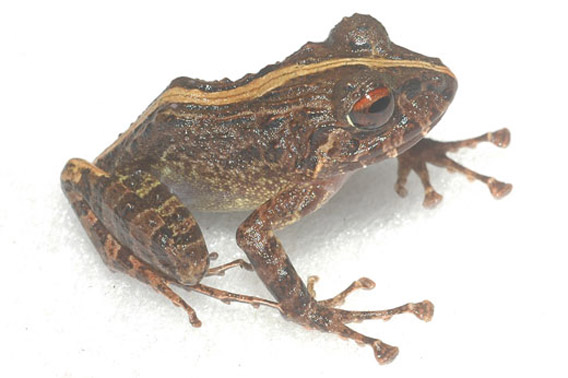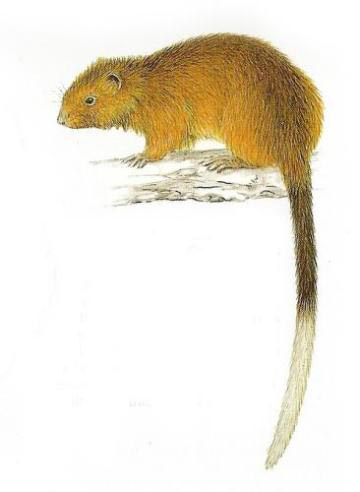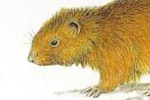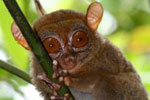
Newly discovered Platymantis species. Photo by: Arvin Diesmos.
Two new frogs have been discovered on the Philippine island of Leyte during a biological survey last year by Fauna and Flora International, which also recorded a wealth of other species. Discovered in November on the island’s Nacolod mountain range, the frogs have yet to be named. The Philippines is one of the world’s global biodiversity hotspots, yet suffers from widespread deforestation and degradation.
“Many (environmental) institutions and funding agencies have written off the Philippines because we only have 20 percent of our forests left,” Aldrin Mallari, Philippine director with Fauna and Flora International, said at a recent forum. “Yet many of these species, even if they are threatened, have this resiliency.”
Mallari’s words were borne out this week by another announcement: the finding of a Dinagat bushy-tailed cloud rat (Crateromys australis) on the Philippine island of Dinagat, just southeast of Leyte Island. The Critically Endangered rodent hadn’t been recorded for nearly forty years and was feared to be extinct, but a researcher and her husband saw the nearly two-foot-long animal on several nights and were able to capture video of it.
 Dinagat bushy-tailed cloud rat. Illustration by William Oliver, Philippines Biodiversity Conservation Foundation. |
The new frogs discovered on Leyte are in the Platymantis genus.
“These species inhabit the montane and mossy forests of the Nacolod Mountain Range in Southern Leyte province,” Mundita Lim, head of the Department of Environment and Natural Resources Protected Areas and Wildlife Bureau (DENR-PAWB), told the Philippine Star. “Both species differ markedly from other known species of Philippine Platymantis frogs by their body size, coloration patterns, and advertisement calls. The two species are allied to two different species groups, the Platymantis guentheri group and Platymantis hazelae group.”
During the survey researchers found hundred of other species, including 229 plants, 31 of which are only found in the Philippines (endemic); 62 reptiles and amphibians, most of which are endemic; 112 birds, 41 of which are endemic ; and 36 mammal species, 17 of which are endemic. The survey recorded 10 species listed as Critically Endangered and 20 species listed as Vulnerable by the IUCN Red List.
Although the Philippines generally receives less conservation attention than its neighbors, 36 new species of plants and animals have been discovered in the country in the last ten years. Despite many environmental problems, the Philippines remains a mega-diverse country, meaning it is in a select group of countries that contain the bulk of the world’s species. A 2008 paper, “Hope for Threatened Tropical Biodiversity: Lessons from the Philippines” in Bioscience, argued that the Philippines was not a lost cause, but rather had seen important conservation progress in recent years, and should be reinstated as a global priority for conservation.
Some statistics from the paper “Hope for Threatened Tropical Biodiversity: Lessons from the Philippines”:
CITATION: Mary Rose C. Posa, Arvin C. Diemos, Navjot S. Sodhi, and Thomas M. Brooks (2008). Hope for Threatened Tropical Biodiversity: Lessons from the Philippines. Vol. 58 No. 3, BioScience.
Related articles
Two-foot-long cloud rat rediscovered after missing for forty years in the Philippines

(04/17/2012) Czech computer programmer, Vaclav Rehak, was the first person to see a living Dinagat bushy-tailed cloud rat (Crateromys australis) in nearly forty years, reports GMA News. Rehak was traveling on Dinagat Island with his new wife, Milada Rehakova-Petru, a specialist on Philippine tarsiers, when he stumbled on the rodent, which has only been recorded once by scientists in 1975. Found only on the Dinagat Island, the rodent was feared extinct, but is now imperiled by mining concessions across its small habitat, which is thought to be less than 100 square kilometers.
Ecosystems in the Philippines bounce back from the brink
(03/19/2008) The Philippines has often been an example for the worst-case-scenario in environmental degradation. Some scientists have even concluded that environmental efforts should put elsewhere, claiming the Philippines to be a lost cause. In his book Requiem for Nature John Terborgh writes the “overpopulated… Philippines are already beyond the point of no return.” However, a recent paper entitled “Hope for Threatened Tropical Biodiversity: Lessons from the Philippines” argues that there are enough positive environmental and conservation trends in the Philippines to have hope and continue working for a better tomorrow.
David vs. Goliath: Goldman Environmental Prize winners highlight development projects gone awry

(04/16/2012) A controversial dam, a massive mine, poisonous pesticides, a devastating road, and criminal polluters: many of this year’s Goldman Environmental Prize winners point to the dangers of poorly-planned, and ultimately destructive, development initiatives. The annual prize, which has been dubbed the Green Nobel Prize is awarded to six grassroots environmental heroes from around the world and includes a financial award of $150,000 for each winner.
Tiny tarsier makes big, ultrasonic noise

(02/13/2012) The Philippine tarsier (Tarsius syrichta), a 5-inch tall Southeast Asian primate, has long resembled a ventriloquist’s doll. It would open its mouth as though chattering away, but researchers heard nothing. Now, a new study in Biology Letters has found out why: the Philippine tarsier communicates ultrasonically, surpassing all other primates, and nearly all terrestrial mammals, in its ability to create sounds in the upper registry.
Giant snakes commonly attacked modern hunter-gatherers in Philippines

(12/13/2011) Humans have an ambivalent relationship with snakes. The legless reptiles are often feared and reviled, becoming stand-ins for the Devil and movie monster characters; yet many people have grown to love snakes, raising large, even dangerous, specimens as pets. Now, new research suggests that the ecological role between snakes and humans, as well as other primates, is more nuanced than expected. After spending decades living among the Agta Negritos people in the Philippines, anthropologist Thomas Headland has found that the hunter gatherer tribes were quite commonly attacked by reticulated pythons (Python reticulatus), while the people themselves had no qualms with hunting, killing, and consuming python.
Photos: 300 species discovered during expedition to Philippines
(06/26/2011) Scientists believe they have discovered more than new 300 species during a six-week expedition to the Philippines.
7 new mice species discovered in the Philippines
(06/16/2011) Seven new species of mice have been discovered in the rainforests of Luzon island in the Philippines, according to the country’s Department of Environment and Natural Resources.
On the edge of extinction, Philippine eagles being picked off one-by-one
(05/23/2011) Down to a few hundred individuals, every Philippine eagle is important if the species is to survive. However, the Philippine Eagle Foundation (PEF) has recently announced that people continue to illegally trap and keep eagles captive. Since December the organization has taken-in four confiscated Philippine eagles (Pithecophaga jefferyi), according to The Philippine Star. One died of a fungal infection after confiscation, while two others has suffered serious injuries.
Expedition in Philippines uncovers one of the world’s rarest mammals along with possible new species
(04/21/2009) A two week expedition into the North Negros Natural Park (NNNP) in the Philippines has led to several discoveries. In the 80,454 hectare park (nearly 200,000 acres), the expedition found what may be new species of insects and plants, in addition to a frog likely unknown to science. They also discovered evidence of the Visayan spotted deer, considered to be the world’s rarest deer and one of the rarest mammals. The team discovered droppings from the deer, which will be analyzed for food content.
Palawan’s wildlife faces extinction risk due to mining, pet trade
(09/17/2008) Scientists warn that species on the Philippine island of Palawan are rapidly headed toward extinction due to habitat loss and the illegal wildlife trade. Last week ornithologist Aldrin Mallari presented a paper showing that all of Palawan’s endangered species inhabited lowland forest, according to an article in the Philippine Daily Inquirer. Lowland forest is broadly open to human development in Palawan, whereas areas above a thousand meters are protected.
New shrew species, orchid discovered in the Philippines
(08/10/2007) An unknown shrew species has been discovered on Palawan, a large island in the Philippines, by a conservation International-led expedition.
Unknown mollusks and crustaceans discovered in the Philippines
(02/05/2007) A French-led marine expedition team may have discovered hundreds of previously unknown species of mollusks and crustaceans around Panglao, an island in the Philippines, according to a report from the Associated Press.
Philippines announces new nature conservation plan
(11/08/2006) Philippine president Gloria Arroyo has enacted a new national conservation policy according to conservation International (CI). Arroyo signed an Executive Order at a Nov. 8 ceremony that stated “It is the policy of the state to protect, conserve and sustainably use biological diversity to ensure and secure the well-being of present and future generations of Filipinos.”







